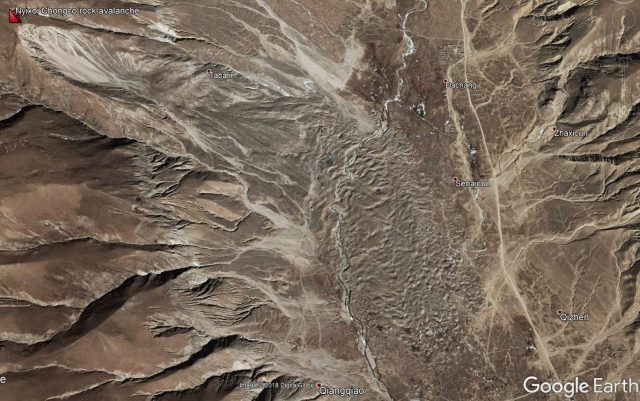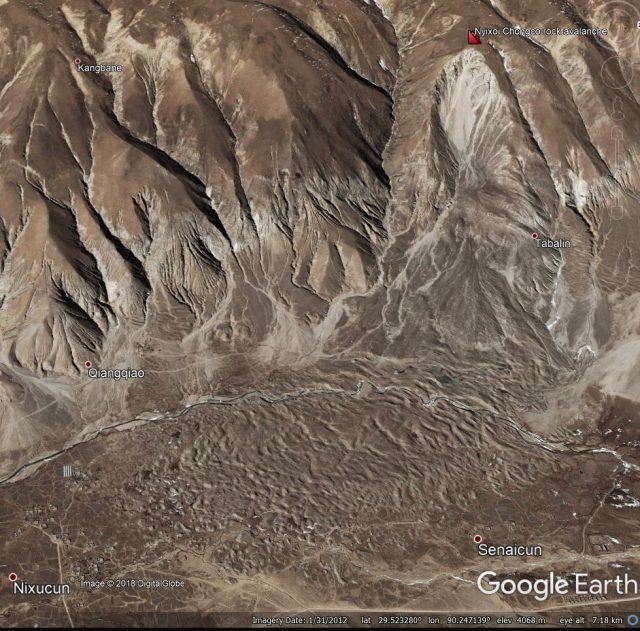14 December 2018
The Nyixoi Chongco rock avalanche in Tibet
Posted by Dave Petley
The Nyixoi Chongco rock avalanche in Tibet
In a new paper in the journal Landslides, Wang et al. (2018) describe the Nyixoi Chongco rock avalanche in Tibet. I have not seen this spectacular rock avalanche in the literature before this paper; it is an excellent addition to the inventory of such events. The dry, low vegetation environment of the Tibetan Plateau has meant that the rock avalanche is beautifully preserved in the landscape. Whilst the paper itself is a little vague on the exact location, I have managed to track it down to 29.534, 90.263, a spot that has excellent Google Earth imagery:-

Google Earth imagery of the the Nyixoi Chongco rock avalanche in Tibet
.
According to Wang et al. (2018), the Nyixoi Chongco rock avalanche involved a mass of 28 million cubic metres descending a vertical distance of 885 metres, and traveling a total of 4.6 km horizontally, representing exceptional mobility. The landslide deposit is about 50 metres thick. The authors do not give an estimated age for the rock avalanche, nor a definite trigger mechanism, but the proximity to active faults makes them suspect that an earthquake might have been involved. Wang et al. (2018) note that a nearby fault is thought to have generated a magnitude 7.0 earthquake about 2,200 years BP; this would have induced sufficiently intense shaking to have triggered a rock avalanche of this type.
The Nyixoi Chongco rock avalanche can be better appreciated in this Google Earth oblique view:-

Google Earth perspective view of the Nyixoi Chongco rock avalanche in Tibet
.
I have placed the marker at the crown of the landslide scar, which has a scoop morphology. Below this is a very clear transportation zone, stripped by the passage of the landslide. The deposit starts from the foot of the slope and extends down the valley. Note the clear hummocks in the landslide mass, which are very common for large rock avalanches. Wang et al. (2018) note that the landslide has many of the common characteristics of large rock avalanche masses, including a very coarse (i.e. boulder-rich) carapace (the surface layer), and a highly fragmented main landslide mass. The base of the landslide mass shows almost no mixing with the valley deposits, and has sedimentary structures that suggest that these deposits were unsaturated when the landslide was deposited. The authors suggest that the movement of the landslide was not associated with any of the complex mechanisms sometimes postulated for these huge rock avalanches, in this case involving simple shear between the landslide mass and the valley floor.
It is interesting to note that this means that the landslide could have high mobility without needing liquefaction or anything more exotic, a finding that is important in the context of understanding other large events.
Reference
Wang, YF., Cheng, QG., Shi, AW. et al. 2018. Sedimentary deformation structures in the Nyixoi Chongco rock avalanche: implications on rock avalanche transport mechanisms. Landslides https://doi.org/10.1007/s10346-018-1117-7


 Dave Petley is the Vice-Chancellor of the University of Hull in the United Kingdom. His blog provides commentary and analysis of landslide events occurring worldwide, including the landslides themselves, latest research, and conferences and meetings.
Dave Petley is the Vice-Chancellor of the University of Hull in the United Kingdom. His blog provides commentary and analysis of landslide events occurring worldwide, including the landslides themselves, latest research, and conferences and meetings.
I am reminded of the Blackhawk slide in southern California.
Also, I think I see a weathered normal fault scarp running thru the slide in a north-south direction. Maybe this is the culprit?